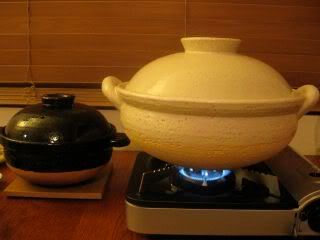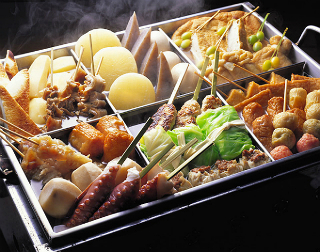If you love Japanese food, you must heard of it once. FYI, Sukiyaki is one of Nabemono type and it is a cold weather food. People in Hokkaido usually eat this at home with their family or co-workers.
Nabemono (鍋物, なべ物) nabe "cooking pot" + mono "thing or things, object, matter" or simply called nabe, refers to a variety of Japanese hot pot dishes, also known as one pot dishes.
In modern Japan, nabemono are kept hot at the dining table by portable stoves. The dish is frequently cooked at the table, and the diners can pick the cooked ingredients they want from the pot. It is either eaten with the broth or with a dip.
The pots are traditionally made of clay (土鍋, donabe) or thick cast iron (鉄鍋, tetsunabe). Clay pots can keep warm for a while after being taken off the fire, while cast iron pots evenly distribute heat and are preferable for sukiyaki. The pots are usually placed in the center of dining tables, shared by multiple people. This is considered the most sociable way to eat with friends and family
Origin
The donabe pot itself can be traced back some 10,000 years in Japan, where it was among the country's earliest uses of earthenware. What the ancient Japanese cooked in the pots is still debated, and the meal known as nabemono was first documented around 200 years ago. Prior to that, a rigid class system precluded shared meals, even among family members. But, when Sukiyaki was introduced in the Meiji era, its popularity quickly spread among the common people, who celebrated the camaraderie and the warmth of these simple one-pot meals, especially on cold winter evenings.
A little of Sukiyaki history:
In Japan, because of religious beliefs people were forbidden to eat beef, venison, horse, mutton and other meat from Asuka era to Meiji era. issue of religion. Cattle and horse were also work animals, therefore if people eat cattle and horse meat, people were punished. This is a commandment of Buddhism. But difficulty in making a living meant that people secretly ate boar and venison meat. Over time people ate beef secretly.
The first sukiyaki store opened in Kyoto at the last days of the Tokugawa Shogunate. The Meiji emperor ate beef. He liked taste of sukiyaki. After that, the emperor lifted the ban on eating beef. People were allowed to eat beef publicly. In the west it is called “Sukiyaki”, in the east it is called “Gyunabe”.
Nabemono Types
There are two types of nabemono in Japan:
- Lightly flavored stock types: typically with miso, soy sauce, dashi, and/or sweet soy. Yudōfu (湯豆腐) and mizutaki (水炊き), eaten with a dipping sauce (tare) to enjoy the taste of the ingredients themselves
- Strongly flavored stock types: typically with miso, soy sauce, dashi, and/or sweet soy. Yosenabe (寄鍋), oden (おでん), and sukiyaki (すき焼き), eaten without further flavoring.
Cooking Varieties
There are more than a hundred nabemono dishes across Japan, many of regional origin that make use of local ingredients. Some of the popular ones that Americans may recognize include shabu shabu (paper thin sliced beef cooked along with vegetables in kelp stock and served with flavored sauce) and sukiyaki (thinly sliced beef cooked in sweetened soy sauce along with vegetables). Other popular nabemono dishes employ tofu, shelled oysters, chicken, pork, assorted seafood, duck or vegetables.
Here are some varieties of nabemono:
- Yosenabe: Yose means "putting together", implying that all things (e.g., meat, seafood, egg, tofu and vegetables) are cooked together in a pot. Yosenabe is typically based on a broth made with miso or soy sauce flavourings
- Chankonabe: Originally for Sumo wrestlers. It is served with more ingredients than any other nabemono. Its original purpose was to help Sumo wrestlers to gain more weight.
- Sukiyaki: Thinly sliced beef, tofu, vegetables and starch noodles stewed in sweetened soy and eaten with a raw egg dip
- Oden: several ingredients such as boiled eggs, daikon, konjac, and processed fishcakes stewed in a light, soy-flavoured dashi broth.
The Food That Bonds People
In homes and restaurants, family and friends gather around a table piled high with raw ingredients vegetables and fish or meat, usually whatever the mood calls for and is fresh or at hand. First, a self-appointed "nabe leader" lights a small portable gas burner under the donabe and begins directing the operation. Then, as the broth begins to simmer, the group gets down to the tasty business of nabemono cooking. Typically, each diner places the ingredients of his or her choice into the broth briefly to cook. The food is then placed into individual serving bowls with some broth and topped with condiments.
And how can it bonds people? Well, to eat nabe, people have to gather around the same table and eat together around the nabe pot. Of course there will be some conversations around and it would bonds them somehow. They said co-workers usually go to eat nabe together to strengthen the communication and bond with the others.
Japanese Favorite Nabe
A survey showed 60% of Japanese eat nabemono more than once a week. The poll also revealed that the most popular style is Yose-nabe, a hotchpotch of whatever foods are available that does not focus on a particular foodaso, nabemono is also a great way to clean out the refrigerator.
"Oden" Japan's second most popular nabemono is Oden, a light broth positively crammed with a selection of fried fish cake, white radish, hard-boiled eggs and seaweed. Oden is also a popular late-night snack among office workers at sidewalk stalls. It is unique among nabemono dishes, as it requires long simmering for the simple ingredients to merge their flavors with the broth.
Third in popularity is Sukiyaki. For many visitors to Japan, Sukiyaki is their first and most memorable introduction to Japanese cuisine.
Nabe Bugyou
Nabe Bugyou is a person who takes charge of cooking nabe. Generally, a nabe-bugyo likes to either take control and cook the entire dish by themselves, or give fastidious cooking instructions and commentaries.
Nabe Bugyou originally an official positions of authority that were outlined during the Edo Period (1603-1867). The work of nabe-bugyo is to add new ingredients as the pot empties and control the cooking and taste of the nabe.
Anime Appearance
 |
| Not from anime but they are mascots from Monster Hunter |
This food also appeared in some anime. I found some anime that have nabe eating scene, such as Gintama, To Aru Kagaku no Railgun, and Yamato Nadeshiko Shichi Henge. Can you mention another title?
 |
| Gintama nabe eating scene |
| To Aru Kagaku no Railgun |
Sources:
Thank you for reading this post! Hope this helps you in some way. See you on the next post ^^






No comments:
Post a Comment